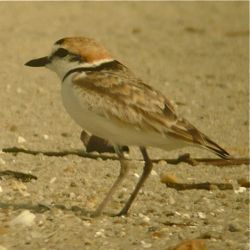On 8th February 2008, Simon Cockayne and Martin Kennewell spent a morning birding at Changi Cove (above). The highlight of their trip was seeing six to eight birds of the newly described “White-faced” Plover.
Simon sent in images of the Malaysian (left top) and White-faced (left bottom) Plovers that he digiscoped, the birds being some distance away.
As Martin writes: “We went in on the new road to the air show. The guard was very reasonable and allowed us entry, we did explain that we wanted to access the coast beyond the air show to go bird watching. We signed the visitor’s book and were given a visitors pass. We drove about two kilometres to where the road u-turns… that allows you to access the coast. It is then a further one kilometre on foot to the site.”
Their morning tally: Lesser Sand Plover (c250), Pacific Golden Plover (c150), Grey Plover (c50), Malaysian Plover (10), Kentish Plover (<5), Red-necked Stint (1), Common Sandpiper (4+), Common Tern (8), Terek Sandpiper (1), Oriental Pratincole (4 flying north), "White-faced" Plover (4 males, 2 non-males, plus maybe 2/3 more). Note: The White-faced Plover is a “mystery” plover first observed by Peter Kennerley (in Singapore, 1993-4) and David Bakewell (in Malaysia, 2006-7) and described in an article published in Surfbirds.com.
These birds occur during the northern winter months of October to March together with flocks of Kentish Plovers (Charadrius alexandrinus), and like the latter, appear to undertake a pre-breeding moult between January and March, suggesting a northern origin. After considering the possibilities of them being hybrids (Kentish x Malaysian), having aberrant plumage or being a poorly known race of a common species, or even an undescribed taxon, the authors concluded that it is most probably a new taxon. However, they suggest that detailed comparison of biometrics and DNA of these birds with those of known taxa be undertaken for comparison.












One Response
Check out David Blakewell’s blog for update:-
http://digdeep1962.blogspot.com/